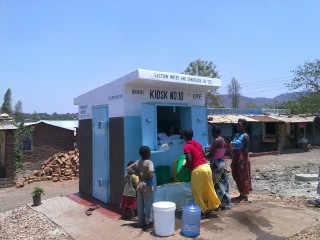On Tuesday, the Lagos state Commissioner for the Environment, Babatunde Adejare, said that the Nigerian government is ready to introduce a Water Distribution Kiosk System. This system is expected to bridge the shortfall in water supply to some areas in the state and connect more residents to the central water system.
“The Water Distribution Kiosk will be a centralised water point to purchase potable water at a substantially cheaper rate, by the water vendors,” said Babatunde.
With a population of about 170 million, only less than 30 percent have access to clean water. Despite the fact that it is the duty of the government to provide water, an essential part of life, the reverse seems to be the case. It is surprising to note that this shortage is not attributed to the rural areas alone. In Lagos, about 40 percent of the 21 million living in the state have limited or no access to water. In spite of the huge traffic in the city and high cost of accommodation, Lagosians spend at least N12,000 on the purchase of 240gallons of water in a month. Most houses do not receive clean water because they are not connected to the state’s central water system.
This deficit in Lagos has been blamed on water pipe vandalism and inconsistent power supply which affects the flow of water in the state. However, it is worthy to note that Nigeria is not the only country in Africa suffering from a water deficit. According to a World Health Organisation and Unicef joint report released in 2015, 332 million people still lack access to potable water. In addition to Lagos, Abidjan, Accra, Dakar and Nairobi were also mentioned as other water-stressed cities.
A viable solution?
In sub-Saharan Africa, water kiosks have been developed as an effective approach to provide safe water to a large number of residents in low-income urban areas. They are now being implemented on a large scale in several countries such as Tanzania, Kenya, Zambia, Malawi, Cameroon, Haiti and South Africa. Several international organisations have been able to provide safe and affordable water in sub-Saharan Africa through the water kiosk system. For instance, the German Development Cooperation has provided safe and affordable water for more than 500,000 through the Impact Water Kiosk project in Africa. If the water kiosk system is managed properly, it can be a strong method to help solve the water scarcity issue in Lagos state.
Here is how the Water Kiosk works in other countries
According to Wikipedia, the water kiosks typically have four taps on the outside and faucets inside, operated by a kiosk attendant. They typically receive treated water from utilities through a piped distribution network. Where water supply in the network is intermittent, kiosks sometimes also have a water storage tank. In rural areas, water for kiosks can sometimes come directly from a well, spring, stream or lake after treatment. An example of a kiosk supplied from a lake is a village near the Gona dam in Kenya.








